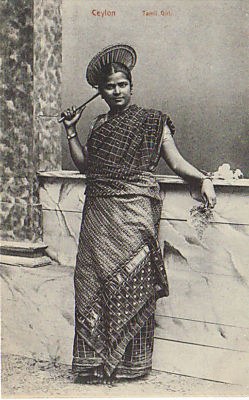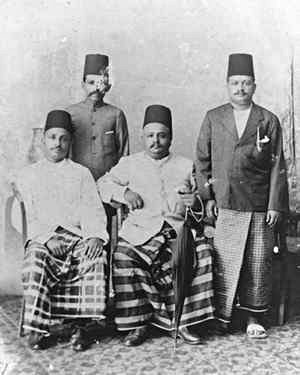
Islam is the third largest religion in Sri Lanka, with about 9.7 percent of the total population following the religion. About 1.9 million Sri Lankans adhere to Islam as per the Sri Lanka census of 2012. The majority of Muslims in Sri Lanka are concentrated in the Eastern Province of the island. Other areas containing significant Muslim minorities include the Western, Northwestern, North Central, Central and Sabaragamuwa provinces. Muslims form a large segment of the urban population of Sri Lanka and are mostly concentrated in major cities and large towns in Sri Lanka, for example Colombo. Most Sri Lankan Muslims primarily speak Tamil language, though it is not uncommon for Sri Lankan Muslims to be fluent in Sinhalese. The Sri Lankan Malays speak the Sri Lanka Malay language in addition to Sinhalese and Tamil.
Paravar is a Tamil and Malayali maritime community, mainly living in the state of Tamil Nadu, Kerala, and in Sri Lanka. Early Pandyas were believed to be Parathavars, due to several similarities of profile. Historically, they were inhabitants of the Neithal (coastal) lands of Tamil Nadu, and find mention in various ancient Tamil literary works.

Indian Tamils of Sri Lanka are Tamil people of Indian origin in Sri Lanka. They are also known as Malayaga Tamilar, Hill Country Tamils, Up-Country Tamils or simply Indian Tamils. They predominantly descend from workers sent from Southern India to Sri Lanka in the 19th and 20th centuries to work in coffee, tea and rubber plantations. Some also migrated on their own as merchants and as other service providers. These Tamil speakers mostly live in the central highlands, also known as the Malayakam or Hill Country, yet others are also found in major urban areas and in the Northern Province. A majority of Hill Country Tamils are predominantly descendants from the lower working castes of South India. Although they are all termed as Tamils today, some have Telugu and Malayalee origins as well as diverse South Indian caste origins. They are instrumental in the plantation sector economy of Sri Lanka. In general, socio-economically their standard of living is below that of the national average and they are described as one of the poorest and most neglected groups in Sri Lanka. In 1964 a large percentage were repatriated to India, but left a considerable number as stateless people. By the 1990s most of these had been given Sri Lankan citizenship. Most are Hindus with a minority of Christians and Muslims amongst them. There are also a small minority followers of Buddhism among them. Politically they are supportive of trade union-based political parties that have supported most of the ruling coalitions since the 1980s.
The caste systems in Sri Lanka are social stratification systems found among the ethnic groups of the island since ancient times. The models are similar to those found in Continental India, but are less extensive and important for various reasons, although the caste systems still play an important and at least symbolic role in religion and politics. Sri Lanka is often considered to be a casteless or caste-blind society by Indians.

Sri Lankan Tamils, also known as Ceylon Tamils or Eelam Tamils, are Tamils native to the South Asian island state of Sri Lanka. Today, they constitute a majority in the Northern Province, form the plurality in the Eastern Province and are in the minority throughout the rest of the country. 70% of Sri Lankan Tamils in Sri Lanka live in the Northern and Eastern provinces.
Sri Lankan Chetties also known as Colombo Chetties, is an elite, royal and a high class ethnicity in the island of Sri Lanka. This Before 2001, they were known as the Sri Lankan Tamil caste, but then after 2001, they were classified as a separate ethnic group in the 2001 census. Now they are known as the Colombo Chetties as a whole. They are an elite class of people who are said to have migrated from India under Portuguese rule but now they are considered as one of the most elite, richest and high classed ethnicities in Sri Lanka and in Colombo. Apart from their titled race, these people showcase no difference from the Sinhala people in Sri Lanka and in the present and nowadays, most chetties grow in Sinhala backgrounds and are basically Sinhala apart from their written identity. "Hetti] is another term used in this context where the term Hetti refers to the present generation of chetties who doesn't have any relation to India but are solely from Sri Lanka.
Bharatha People also known as Bharatakula and Paravar, is an ethnicity in the island of Sri Lanka. Earlier considered a caste of the Sri Lankan Tamils, they got classified as separate ethnic group in the 2001 census. They are descendant of Tamil speaking Paravar of Southern India who migrated to Sri Lanka under Portuguese rule. They live mainly on the western coast of Sri Lanka and mainly found in the cities of Mannar, Negombo and Colombo.
Negombo Tamils or Puttalam Tamils are the Tamil speaking ethnic Karavas who live in the western Gampaha and Puttalam districts of Sri Lanka. They are distinguished from other Tamils from the island nation by their unique dialects, one of which is known as Negombo Tamil dialect. Other sub categories of native Tamils of Sri Lanka are Jaffna Tamils or Northern Tamils and Batticalao Tamils or Eastern Tamils from the traditional Tamil dominant North and East of the Island nation. Negombo is a principal coastal city in the Gampaha District and Puttalam is also the principal city within the neighbouring Puttalam District.

Negombo is a major city in Sri Lanka, situated on the west coast and at the mouth of the Negombo Lagoon, in the Western Province, 38 km (24 mi) from Colombo via the Colombo–Katunayake Expressway and the nearest major city from the Bandaranaike International Airport.
Karaiyar is a Sri Lankan Tamil caste found mainly on the northern and eastern coastal areas of Sri Lanka, and globally among the Tamil diaspora.

Karava is a Sinhalese speaking ethnic group of Sri Lanka, whose ancestors migrated throughout history from the Coromandel coast, claiming lineage to the Kaurava royalty of the old Kingdom of Kuru in Northern India. The Tamil equivalent is Karaiyar. Both groups are also known as the Kurukula.
Sinhalisation is a term, derived from Sinhala, that has number of meanings in Sri Lanka. it is mainly the assimilation into Sinhalese Culture in which the members of an ethno-cultural group are steadily integrated or "absorbed" into established Sinhalese culture.

The Sri Lankan Tamil dialects or Ceylon Tamil or commonly in Tamil language Eelam Tamil are a group of Tamil dialects used in Sri Lanka by its native Tamil people and Eastern Moors, and Coast Veddas that is distinct from the dialects of Tamil spoken in Tamil Nadu and Sri Lanka. It is broadly categorized into three sub groups: Jaffna Tamil, Batticaloa Tamil, and Negombo Tamil dialects. But there are number of sub dialects within these broad regional dialects as well. These dialects are also used by ethnic groups other than Tamils and Moors such as Sinhalese people, Portuguese Burghers and the indigenous Coastal Vedda people.

Sri Lankan Moors are an ethnic minority group in Sri Lanka, comprising 9.3% of the country's total population. Most of them are native speakers of the Tamil language. The majority of Moors who aren’t native to the North and East also speak Sinhalese as a second language. They are predominantly followers of Islam. The Sri Lankan Muslim community is mostly divided between Sri Lankan Moors, Indian Moors, Sri Lankan Malays and Sri Lankan Bohras. These groups are differentiated by lineage, language, history, culture and traditions.
Negombo Tamil dialect or Negombo Fishermen's Tamil is a Sri Lankan Tamil language dialect used by the fishers of Negombo, Sri Lanka. This is just one of the many dialects used by the remnant population of formerly Tamil speaking people of the western Puttalam District and Gampaha District of Sri Lanka. Those who still identify them as ethnic Tamils are known as Negombo Tamils or as Puttalam Tamils. Although most residents of these districts identify them as ethnic Sinhalese some are bilingual in both the languages.

Tamil-Brahmi, also known as Tamili or Damili, was a variant of the Brahmi script in southern India. It was used to write inscriptions in the early form of Old Tamil. The Tamil-Brahmi script has been paleographically and stratigraphically dated between the third century BCE and the first century CE, and it constitutes the earliest known writing system evidenced in many parts of Tamil Nadu, Kerala, Andhra Pradesh and Sri Lanka. Tamil Brahmi inscriptions have been found on cave entrances, stone beds, potsherds, jar burials, coins, seals, and rings.
Sri Lankan Vellalar is a caste in Sri Lanka, predominantly found in the Jaffna peninsula and adjacent Vanni region, who comprise about half of the Sri Lankan Tamil population. They were traditionally involved in agriculture, but also included merchants, landowners and temple patrons. They also form part of the Sri Lankan Tamil diaspora.
Social class in Sri Lanka is often described as casteless, though caste is still found on the island in both a symbolic and a practical sense. Caste is also used in an analogous sense to refer to the new social class divisions that have appeared in recent decades. The combination of ethnic nationalist movements that saw caste as an island-wide dividing tool, strong emphasis on providing access to education and healthcare regardless of background, and historic lack of discrimination among the colonial civil service played a factor in eradicating the caste system in most sectors of the island's society. Although the Buddhist culture actively fought against all forms of class discrimination, many Buddhist organizations used caste as a method to extract surplus from temple property.

Tamil settlement of Sri Lanka refers to the settlement of Tamils, or other Dravidian peoples, from Southern India to Sri Lanka. Due to Sri Lanka's close proximity to Southern India, Dravidian influence on Sri Lanka has been very active since the early Iron Age or megalithic period.
Pattanavar is a Tamil caste found in Tamil Nadu, India.








